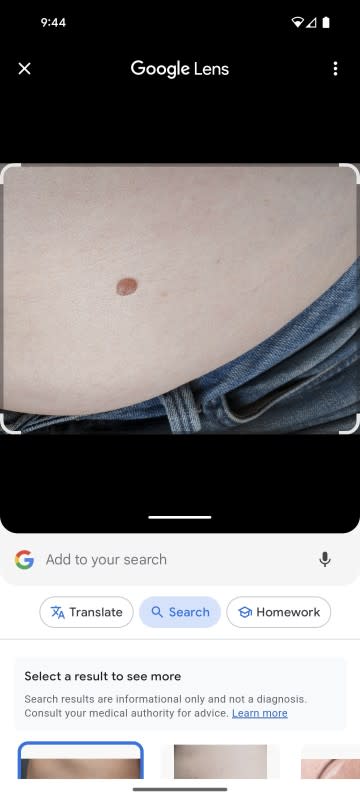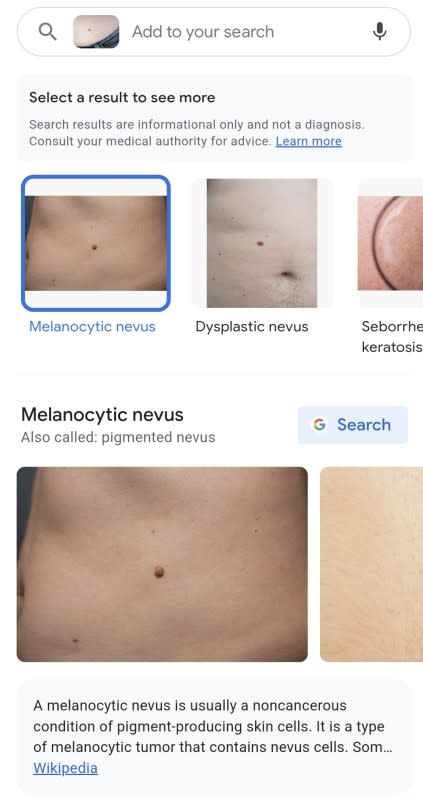‘I Used Google Lens To Check for Skin Cancer—Here’s What Happened’

Artificial technology (AI) is definitely one of the hottest topics right now. From using ChatGPT to make travel itineraries to having a Grammarly plug-in that catches grammar mistakes, it’s making life easier in many ways.
As a wellness writer and someone interested in living my healthiest life, I started wondering how I could use AI to support my health. When I heard about the idea of using my Google Lens (image recognition technology that compares the object in a picture to other images) to check my skin for anything concerning (like suspicious moles or spots), I was intrigued. Maybe it would cut down on those yearly exams with a dermatologist!
After all, I already use Google Lens to identify beautiful bird species in my backyard and actors in movies. If it can tell me where else I’ve seen a familiar-looking actor before, maybe it could tell me if a mole on my body is normal or worth getting checked out by a derm.
To learn more, I talked to both a product manager at Google (to make sure I was using Google Lens correctly to do a skin check) as well as a dermatologist unaffiliated with Google before doing a skin check on myself. Here’s what I learned.
Related: Cleanse, Moisturize, Snack! Here Are the 25 Best Foods for Your Skin
How To Use Google Lens to Check Your Skin for Suspicious Spots
Dr. Peggy Bui, MD, MBA, an internal medicine doctor and Group Product Manager at Google, says that skin health is a very common topic people turn to Google to learn about. “Since Google’s earliest days, we’ve focused on helping people connect to the information they’re seeking. In fact, each year we see around 10 billion searches related to skin, hair and nail conditions. But describing something on your skin can be difficult to articulate with words alone,” she explains.
That’s where she says that using Google Lens can come in handy. Google Lens is an app for Android and iOS that provides visual matches to inform a search. “With our visual search tool, Google Lens, we added the ability to search conditions that are visually similar to what you see on your skin,” Dr. Bui explains.
To try it out, Dr. Bui says to simply take a picture or upload a photo through the Google Lens app. Then, what pops up are visual matches similar to the photo you took. “From there, you can tap on the thumbnail of the condition that most resemble yours—and explore more information about that condition,” she shares.
For example, Dr. Bui says that one way to use Google Lens for skin health is to take a photo of a rash or bump if you aren’t sure what it is. If you aren’t quite sure how to describe what you’re seeing on your skin, this is when she says taking a photo using Google Lens can be more helpful than simply going straight to the search bar for answers.
“The most important thing to remember is that this feature is not meant to be a diagnostic tool, and you should always consult your doctor for any medical advice. Our goal is to help people find helpful information about their skin concerns,” Dr. Bui says.
That means if you have any suspicions at all about something on your skin, you should still book that dermatologist appointment. Google is not a replacement for a doctor.
Related: How Do Anti-Aging Skincare Products Work? Dermatologists Explain
What Happened When I Gave It a Try
I have a Google Pixel 8, so Google Lens is already integrated into my phone’s camera. That means I didn’t have to download anything to use it. My skin is fair and while I do have quite a few freckles (and age spots as I’ve gotten older), none of them are new to me or have been causing me to lose any sleep.
I do have a sizable mole on my tummy that I decided to use the Google Lens to check out. Would it be able to identify it? I used my phone to snap a photo of it and then clicked the “Lens” icon in my camera features. The first photo that Google Lens matched it with was an image captioned “melanocytic nevus,” a term I’d never heard before. Immediately, I started to tense up. “Melanocytic” sounds pretty close to “melanoma.” Do I have cancer?

Emily Laurence
Since the first image on Google Lens that matched with mine came from Getty Images and didn’t have any information, I went to the second photo, which came from a place called Northland Dermatology, located in Kansas City. This led me to a general article about moles and skin cancer checks; it didn’t have any info on melanocytic nevus.
The other correlating pictures led me to similar articles, so I decided to stop using Google Lens and turn to my actual Google search bar to look up “melanocytic nevus.” The first hit was from Yale News, a credible source in my eyes. I clicked and learned that “melanocytic nevus” is just the scientific term for mole.
Great, so I just freaked out over nothing. It seems like using Google Lens to learn about health is really similar to using the Google search bar: in both cases, you can freak out and assume you have cancer.
Next, I aimed my camera at an age spot that I’ve noticed on my hand. The older I get, the more age spots I notice forming on my skin. Is this one a cause for concern? This time, Google Lens identified the spot as “lentigo” with an image sourced from Wikipedia. According to Wikipedia, it’s harmless. No freak out this time.
Fortunately, I didn’t have anything that I was truly worried about on my skin to snap photos of, but I still decided to ask a dermatologist for her opinion on using Google Lens for skin checks.

Emily Laurence
Related: 'I'm a Dermatologist and These Are the Foods I Always Avoid for Skin Health'
What a Dermatologist Thinks
Dr. Lindsay Ackerman, MD, FAAD, a board-certified dermatologist with U.S. Dermatology Partners Phoenix, is straightforward when it comes to what she thinks about using Google Lens to check your skin: She’s skeptical and doesn’t recommend it.
“While technology in visual interpretation may be of assistance in rendering accurate diagnoses in some, the most problematic feature is that an untrained individual—which is for whom the platform is being developed and marketed—would not be able to identify if they are receiving correct, or incorrect information. This can lead to potentially devastating consequences,” she says.
Dr. Ackerman worries that if a mole or spot is incorrectly identified as safe, it could prevent someone from seeking potentially life-saving help. Alternatively, she says if it incorrectly identifies a skin spot as dangerous, it could cause someone to unnecessarily freak out (like I did).
Dr. Bui maintains that Google has a high bar when it comes to quality results across all their search tools, including Google Lens. “As with any update to Lens, we looked at a range of different metrics and inputs, such as user feedback, to understand how we can improve accuracy for visual results in particular. We worked closely with physicians and researchers to ensure we are building high-quality features to help people with their health searches,” she says.
In general, it seems that using Google Lens for skin checks should only be done preliminarily. Both Dr. Bui and Dr. Ackerman emphasize that it isn’t meant to take the place of a real doctor. It’s simply an alternative to using a search bar. For now, there’s no replacing those annual dermatologist appointments, so keep them on the books!
Next up, these are the 10 most common chronic skin conditions and what you need to know about them.
Sources
Dr. Peggy Bui, MD, MBA, internal medicine doctor and Group Product Manager at Google
Dr. Lindsay Ackerman, MD, FAAD, board-certified dermatologist with U.S. Dermatology Partners Phoenix
